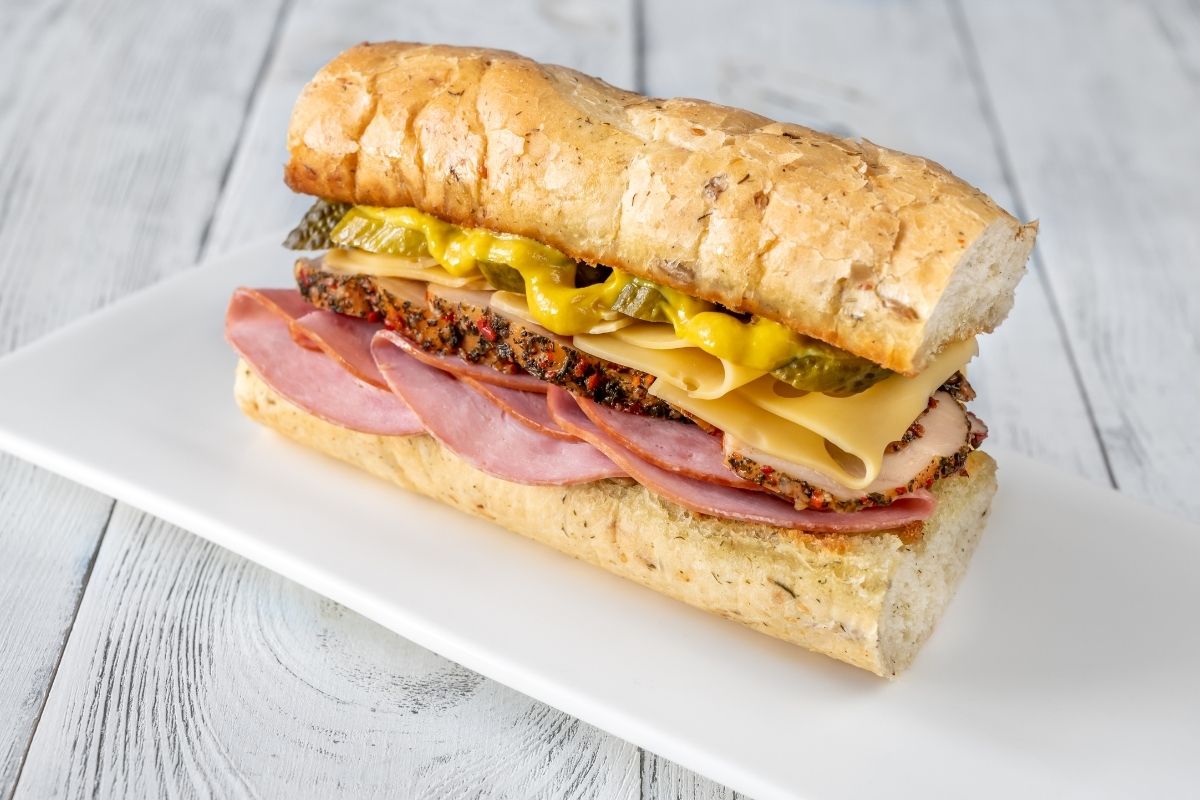In many ways, the infamous Cuban sandwich is as mysterious and enticing as its eponymous island nation.

This mouthwatering snack’s origins are a little hazy, giving it an almost mythic countenance in popular culture, similar to that of ancient folk songs and the horror stories told endlessly around flickering campfires.
And much like folk songs and horror stories, the sandwich has been passed on and on, traveling hundreds of miles, across oceans even, and now, is a world-renowned delicacy of the working classes.
A savory treat that takes the sting out of a Sisyphean workload.
Yep, the Cubano is a hearty snack and an ephemeral concept, but let’s see if we can’t uncover some of the mystery surrounding the creation of this sacred sandwich.
What’s The Cuban Sandwich’s Story?
Thanks to a tangle of conflicting claims and very little historical evidence to back any one idea up, the only concrete thing we can say about the origins of the Cuban sandwich is that it is a product of Cuban culture.
Now, you’d be forgiven for thinking that, due to the name of this brilliant meal, its geographical beginnings would be obvious, but not so, as many posit that it wasn’t created in Cuba at all.
The reason people have to doubt its country of origins is that in the mid to late 1800s, travel between Cuba and Florida was a constant, facilitating the blending of multiple cultures and ideas into one another, and as this international back and forth was largely undocumented, it’s hard to give something like the Cuban sandwich a definite origin.
Although it may well have been invented somewhere in Cuba, it could just as well have been created on American soil as a result of Cuban workers inhabiting the Florida coast.
Arguments For The Sandwich Originating In Cuba
The Taino Tribe

Some say that the idea of the Cuban sandwich was developed by the Taino Tribe, an Arawakan-speaking civilization native to the Caribbean.
It’s alleged that these tribespeople introduced this prototypical sandwich and spread it throughout Cuba.
Initially, the as-yet-unnamed signature sandwich of the nation would have been a relatively simple snack, but over the years, as more and more colonists arrived on the island, the DNA of the Cuban sandwich began to shift.
The Spanish, for instance, had an astronomical influence on most aspects of life in Cuba.
They altered the architecture, forced the natives to accept bullfighting as their national sport, and imported countless slaves to work the sugar cane fields.
It’s only natural that the Spaniards would want to leave their mark on any established nationally-renowned snacks too, and so, allegedly, they added pork and ham to the list of ingredients.
The Cigar Factories Of Cuban Cities
Perhaps a more popular notion is that the traditional Cuban pressed sandwich originated in the large cigar factories of Cuban cities such as Havana and Santiago de Cuba.
Although we cannot trace the sandwich’s roots back to one specific place or person, it seems reasonable that a certain affordable, portable, and delicious snack would grow in favor among the working class of Cuba.
It will have started in a fairly localized way in a single factory, then word of the sandwich no doubt spread from the workers to their families, and then to the general population of the area and beyond.
Arguments For The Sandwich Originating In The States
It seems likely that a rudimentary version of the Cubano was indeed crafted in Cuba at some point in time, but the modern Cuban, the sandwich that we know and love today, was undoubtedly created on American soil.
Think about it… Cubans wouldn’t call their signature snacks a Cuban sandwich.
This name was undoubtedly given to the sandwich in America by Americans in response to the growing Cuban communities in coastal Florida cities.
Let’s explore this part of the Cuban sandwich’s history in more detail.
The Cigar Factories Of Key West
Being so close to Cuba, it’s no surprise that a number of cigar factories were erected in Key West, as the tobacco could easily be imported from Cuba alongside numerous experienced workers to process the crop.
It might be more reasonable to think that the Cubano already existed in the minds of these skilled Cuban migrants, but without certainty, there is a chance that the sandwich was dreamt up as a practical and tasty lunch right there in Key West, although the earliest actual mention of the modern Cuban sandwich was not discovered in Key West, but Tampa.
The Cigar Factories Of Tampa

As the 19th century neared its end, the migrant city of Ybor was founded by titan of the cigar industry, Vicente Martinez-Ybor, which sparked the shifting of Florida cigar production to Tampa, in which Ybor City resided.
Migrant workers flocked to the city in the tens of thousands. Many were from Cuba, but Spaniards and Italians made up a great deal of the exodus as well.
So great were their numbers that they effectively transformed Tampa from a modest village into the bustling city we recognize today.
It’s in the worker’s cafés of Ybor City that we discover the very first mention of the modern Cuban sandwich, along with a detailed description of its composition.
For this reason, historians generally agree that the Cuban sandwich found on menus today originated in this West Florida area.
That isn’t to say that the sandwich wasn’t conceived in Cuba.
As historian Loy Glenn Westfall states, the sandwich was “born in Cuba and educated in Key West”, and we can assume, reached its peak composition in Tampa.
The Cuban Revolution: A Sandwich On Tour
When Fidel Castro and his 26th of July Movement overthrew the military dictatorship of Batista in Cuba, and a new socialist ethos was governing the land, many Cubans were either exiled or left of their own volition, leading to an influx of migrant workers arriving in Miami.
Now, as we’ve seen so far, the infamous sandwich seems to go wherever the Cuban migrants do, and this was no exception.
The snack started popping up on café menus all over the city. But it didn’t stop there!
Exile communities of Cuban migrants were being established all over the States, particularly in New York, New Jersey, and Chicago, so along went the Cuban sandwich.
The Cubano even got another chance to go international, as many Cuban migrants chose Puerto Rico as their destination rather than the US.
Regional Variations Of The Cuban Sandwich
The traditional ingredients of a classic Cuban sandwich are as follows:
- Cuban bread sliced at lengths of 8–12 inches
- Butter for the bread, or perhaps even a drizzle of olive oil
- A light spread of mustard
- Glazed ham
- Roast pork — typically Pernil which is sometimes marinated in mojo sauce
- Thinly sliced dill pickles
… However, the composition of this storied sandwich fluctuates famously depending on the region you place your order.
The big controversy, and the cause of a long-standing passionate, yet friendly rivalry, is the inclusion of salami.
These days, if you order your Cuban in Tampa, you won’t get salami in your sandwich, but if you order your Cuban in Miami, you will get salami.
Historians believe this is because Miami hosted a significant number of Italian immigrants alongside their Cuban population, and it’s been a point of culinary contention between the cities ever since.
Final Thoughts: The Legacy Of The Cuban Sandwich
Today, the Cuban sandwich has become a ubiquitous menu staple across the United States, and, of course, the world.
The impact it has had on the culture and cooking of its destinations is nothing short of seismic, evidenced by the fact there are now Cuban sandwich festivals, and the legendary snack even became the co-star of Jon Favreau in the hit movie, Chef.
How many other sandwiches can boast such a resume? None, we’d argue!
- What Is The Largest Island In Cuba? - September 19, 2022
- Havana – Why Is It Cuba’s Most Exciting City? - September 19, 2022
- Cheapest Time To Visit Cuba (Ultimate Guide) - September 19, 2022








